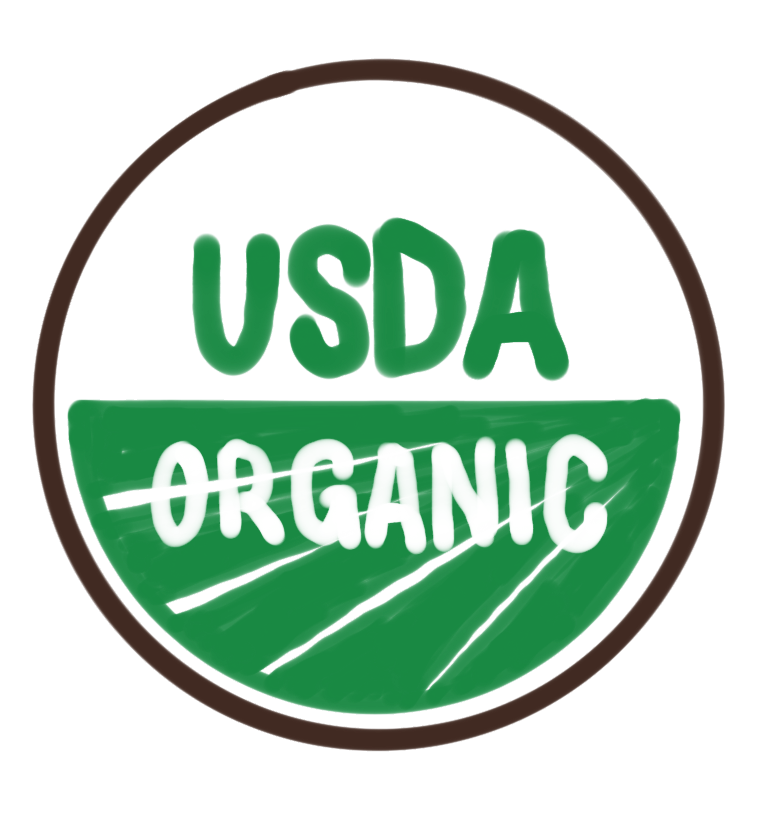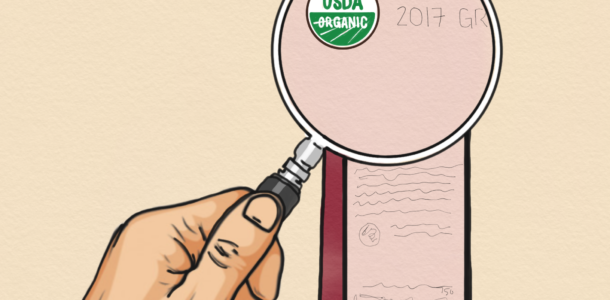A primer on organic wine certification levels and what they mean from our friend Amanda Simpson of organic wine distributor Mountain Peoples Wine.
“I have a clear understanding of organic wine labeling and can confidently select wines that match my values…”, said no one ever. Wine labels are confusing. For consumers who want to purchase wines that are grown organically, made organically, or both, it gets even more complicated. As the leading California distributor of organic wines for 25 years, we know a little something about organic labeling and would like to share some tips on how to decipher organic wine labeling.
Want to avoid added sulfites? Then a wine carrying the USDA organic seal is your ticket. Know that sulfites do occur naturally, but with a USDA organic wine you can be assured that no sulfites have been added during the winemaking process and that the naturally occurring sulfites are under 10 parts per million. Additionally, the seal guarantees that the grapes have been certified organic by a 3rdparty, processed in a certified organic facility and any ingredients used in the winemaking process are approved by the National Organic Program (NOP). A wine displaying the USDA seal is the only wine that is recognized as being fully organic. RJ note: To make matters more confusing, there are many small producers making wines with no added sulfites (NAS) who are not certified, or are certified in the EU by a certifying body which is not recognized by the USDA, which is tricky for a consumer and requires you to build relationships with a trusted retailer to guide you to NAS wines without the USDA organic seal.

If you’re more concerned with growing practices than you are sulfites, then a “Made with Organic Grapes” wine is a suitable choice. You’ll often see this statement displayed on the front wine label, and despite language that might imply otherwise, it also dictates winemaking practices. Similar to a USDA organic wine, “Made with” wines must also be processed in a certified facility using certified grapes and NOP allowable ingredients; however, the key difference is sulfite addition. The USDA does not recognize So2 as an organic ingredient, thus disqualifying otherwise organic wines from displaying the USDA seal if there is any addition of sulfites. It is worth noting though that in a “Made with” wine, sulfite levels are capped at 100 parts per million. To give some perspective, conventional wines allow up to 350 parts per million, so by industry standards under 100 ppm is relatively low. RJ note: by Rock Juice standards, however,100ppm is still high. All of the wines we work with have 50ppm of added sulfites or less – and generally, the wines we love are way less, between 0-20ppm added So2.

There is a 3rdtier of organic labeling that requires you to scour the back label where you’ll find in tiny lettering “Ingredients: Organic Grapes.” This label applies solely to the grapes which are 3rdparty certified, but the winemaker has the option to employ non-organic methods in the cellar. Conventional processing aids are allowed as well as sulfites up to 350 ppm. While not as stringent as the above two categories, what you are avoiding when choosing this type of wine are the multitude of synthetic pesticides, herbicides, fungicides, and fertilizers that are used in most conventional vineyards, of which there are many. In California the Public Health Institute makes available to the public a mapping tool that outlines agricultural pesticide applications within the state. It’s both informative and nightmare-inducing, but an invaluable resource, nonetheless. If you want to satisfy your morbid curiosity for how many pounds of carcinogens were applied to wine grapes in say, Napa County, then enter the rabbit hole… https://www.trackingcalifornia.org/pesticides/pesticide-mapping-tool

Beware “Certified Sustainable” wines: if you’re wanting to avoid synthetic pesticide applications like Glyphosate, the active ingredient in Round Up, understand that many sustainable certifiers do not prohibit its use. While sustainable programs do signify an adoption of more sustainable methods, they are in no way organic. To give you an example, Sonoma County recently touted that 99% of their county’s vineyards are now certified sustainable; however, as revealed by the handy-dandy mapping tool referenced above, Sonoma County applied an average of 81,319 pounds of Glyphosate annually to vineyards alone between 2014-2017 (Organic Wines Uncorked, Sept 13 2019). Does that seem sustainable to you? I think not. The work that these programs are doing is important and should be encouraged, but if you want the gold standard in sustainability, choose a wine that is both certified sustainable AND organic.
In this bewildering world of wine where every producer is competing for your attention and ultimately your hard-earned dollar, it’s become lucrative to jump on the “green” wagon and market yourself as such. It’s easy to be lured by terms such as “sustainable,” “green,” and “organic-in-practice”, but none have the same regulatory practices in place nor is the commitment as significant as organic. If you want a guarantee that your wine hasn’t been sprayed with Glyphosate, or if you want to support the good work that organic farmers are doing for the environment, their workers and communities, then look for the USDA Organic seal, Made with Organic Grapes, or Ingredients: Organic Grapes. Outside of visiting a vineyard in person and vetting for ourselves, the Organic Program is the best assurance we have as consumers guaranteeing non-toxic farming practices. Whichever tier you choose, feel confident that your choice is supported by a 3rdparty certifier who has already done the work for you.







No comments yet.